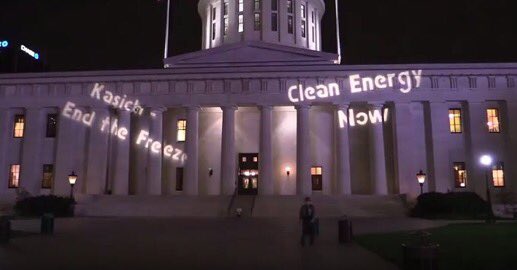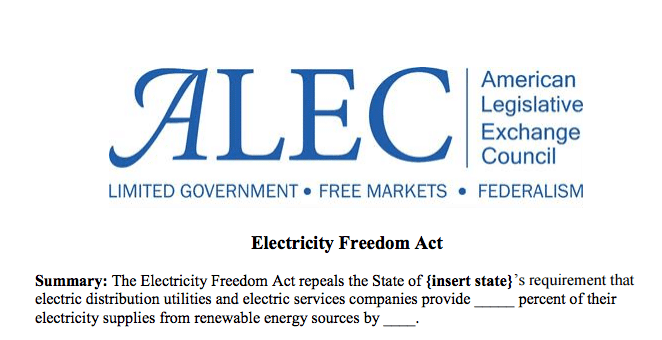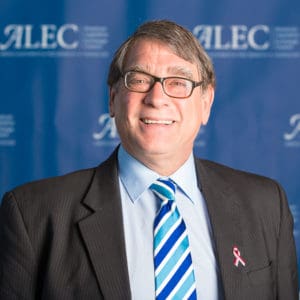December 28, 2016 update: Republican Governor John Kasich has vetoed legislation – HB 554 – that would have effectively extended the freeze on Ohio’s clean energy standards for another two years by making them voluntary. The standards will now be unfrozen on January 1, 2017, a significant win for supporters of renewable energy and energy efficiency standards and a notable loss for the fossil fuel and utility interests that lobbied behind the scenes to continue the freeze.
Fossil fuel and utility interests have used lobbyists and 2016 campaign contributions to influence state legislators in Ohio, and to drive renewed attacks on clean energy policies in the Buckeye State.
Companion bills – HB 554 and SB 320 – in the Ohio House of Representatives and Senate would effectively continue the controversial freeze on Ohio’s renewable energy and energy efficiency standards until 2020. The Ohio House just passed its version of the bill.
There has been no shortage of public support for unfreezing Ohio’s clean energy standards, but behind the scenes, fossil fuel and utility interests have been using money to influence the debate in Columbus.

Clean energy supporter Ohio Citizen Action projected its call for Governor John Kasich to end the freeze onto the state house in Columbus.
Utility, coal, and oil lobbyists are behind attacks on clean energy in Ohio
According to disclosure forms filed with the Ohio Lobbying Activity Center, a number of electric utility companies have paid their lobbyists to engage in “active advocacy” on SB 320 and/or HB 554 during 2016:
- American Electric Power (AEP)
- Dayton Power & Light
- Duke Energy Dynegy, Inc.
- Exelon Generation Company, LLC
- First Energy
- NRG Energy, Inc
- NextEra Energy Resources
AEP and FirstEnergy have publicly backed efforts to freeze Ohio’s clean energy standards before. And last year, Dynegy favored continuing the freeze in testimony before the Energy Mandates Study Committee. Other electric utilities have been relatively coy about their positions on SB 320 and HB 554 publicly, but apparently have not been shy about lobbying on the bills behind closed doors.
Lobbyists for the utility industry have filed disclosure forms populated with expenditures on meals and events for state legislators. For example, a bevy of FirstEnergy lobbyists disclosed spending $1,068 for an “RNC Reception” that all state legislators were supposedly invited to, during the same time period that they lobbied on SB 320 and HB 554.
Lobbyists for several major fossil fuel companies have also lobbied on SB 320 and HB 554, including:
- ExxonMobil
- Marathon Petroleum Corporation
- Murray Energy Corporation
ExxonMobil remains a leading member and funder of the American Legislative Exchange Council, which has for several years peddled a so-called “model policy” written by the climate change denying Heartland Institute and aimed at rolling back state renewable energy standards like Ohio’s.

A portion of the American Legislative Exchange Council’s “Electricity Freedom Act” aimed at repealing state renewable energy standards.
In 2014, Ohio Senator Bill Seitz denied that SB 310, which froze the state’s clean energy standards through 2016, was influenced by ALEC. However, ALEC has since pointed to passage of SB 310 as one of the few signs of success for its campaign against renewable energy standards.

Ohio Senator Bill Seitz is a member of ALEC’s board of directors who has compared renewable energy standard policies to “Joseph Stalin’s five year plan”
Senator Seitz, who has now sponsored SB 320 to continue the freeze, remains a member of ALEC’s board of directors. Seitz also spoke on a panel on “Renewable energy mandates reform” at ALEC’s 2015 Annual Meeting, which was sponsored by AEP, Duke Energy, and ExxonMobil. AEP has since joined the more than 100 corporates that have left ALEC, but the company is still trying to implement ALEC’s dirty energy agenda in Ohio.
Lobbyists for industry associations that represent fossil fuel and utility interests have also lobbied on SB 320 and HB 554, including:
- Alliance for Energy Choice
- American Petroleum Institute – API Ohio
- Industrial Energy Users of Ohio
- Ohio Chamber of Commerce
- Ohio Coal Association
- Ohio Gas Association
- Retail Energy Supply Association
Attorney and lobbyist Samuel Randazzo has for years led the Industrial Energy Users of Ohio’s (IEU-Ohio) attacks on clean energy in Ohio. The group’s membership includes several utilities as Vendor Affiliates, including FirstEnergy Solutions. IEU-Ohio has promoted itself as an “active partner in shaping” the SB 310 freeze on renewables and energy efficiency. And Randazzo has been called “a chief guide on Ohio utility legislation” by his law firm, McNees, Wallace, and Yurick, LLC.
Fossil fuel & utility interests have used campaign contributions to curry favor in Columbus
According to Ohio’s campaign finance database, the primary sponsors of HB 554 and SB 310 have received 2016 campaign contributions from some of the same fossil fuel and utility interests that have lobbied on their bills:

Ohio Representative Ron Amstutz is also a member of ALEC.
Representative Ron Amstutz: primary sponsor of HB 554
- Duke Energy: $1,250
- Ohio Coal Association: $500
- Samuel Randazzo: $250
Senator Bill Seitz: primary sponsor of SB 320
- Dayton Power & Light: $1,000
- Duke Energy: $3,500
- FirstEnergy: $2,500
- Ohio Chamber of Commerce: $350
- Ohio Coal Association: $700
- “MCNEES, WALLACE AND NURICK BY SAM RONDAZZO”: $1,350**
Term limits prevented Senator Seitz from seeking another term in the Ohio Senate in 2016, but a loophole allowed him to run for and win back his old seat in the Ohio House, where he will soon serve as Policy Chair.
Earlier this year, PolluterWatch provided a useful roundup of the campaign cash that Senator Seitz and Representative Amstutz have previously received from fossil fuel and utility interests.
Campaign contributions from these same special interests have also helped to fuel the campaigns of the president of the Ohio Senate and the speaker of the Ohio House, as well as the majority caucuses for both chambers.
- AEP: $12,500
- Duke Energy: $2,500
- First Energy: $10,500
- Ohio Chamber of Commerce $1,850
- Ohio Coal Association $1,500
- Samuel Randazzo: $1,750
Representative Cliff Rosenberger:
- AEP: $12,500
- Dayton Power & Light: $1,500
- Duke Energy: $3,750
- ExxonMobil: $5,000
- FirstEnergy: $12,750
- Marathon Petroleum: $6,500
- Ohio Chamber of Commerce: $2,000
- Samuel Randazzo: $1,000
- Timken/TimkenSteel: $1,350
Ohio House Republican Organizational Caucus:
- AEP: $18,500
- Dayton Power & Light: $500
- FirstEnergy: $18,796.51
- Murray Energy: $17,500
- Ohio Coal Association: $6,500
- Samuel Randazzo (lobbyist for Industrial Energy Users): $5,000
Republican Senate Campaign Committee:
- AEP: $16,000 on 12/31/2015 (basically 2016)
- Duke Energy: $3,750
- FirstEnergy: $18,798.51
- Murray Energy: $15,000
- Ohio Coal Association: $5,500
- Samual Randazzo: $1,000
Fossil fuel funded special interest groups have targeted Ohio too
A recent story in the Los Angeles Times provided an update on the funding behind two associated climate skeptic groups that have been involved in attacks on clean energy in Ohio. The American Energy Alliance (AEA) and Institute for Energy Research (IER) together received at least $3 million from the Koch network in 2015, according to the Times. The groups also have financial ties to coal interests, including Alpha Natural Resources and Peabody Energy.
Donald Trump has tapped Thomas Pyle, the president of AEA and IER, to lead his Department of Energy Transition team. The pick has fueled concerns that the incoming administration will pursue the same kind of ideological attacks on clean energy that have impacted Ohio. A leaked memo on Trump’s “likely” energy policies that was written by Pyle and obtained by the Center for Media & Democracy affirms those fears.
Governor John Kasich, a Republican, has spoken out against efforts to continue the freeze on clean energy in Ohio, telling reporters that he does not want to see the Buckeye State have to endure any more bad headlines on the issue. In fact, most states with renewable energy standards have chosen to stand by their bipartisan commitments to clean energy, and reject the disinformation campaign funded by fossil fuel and utility interests. These states will continue to lead the way on clean energy, regardless of what direction the Trump administration decides to take on energy.
The clean energy economy in Ohio is still heating up, despite the freeze. Governor Kasich will soon have another chance to embrace the facts and reestablish Ohio as a true clean energy leader by vetoing SB 320 and HB 552.

